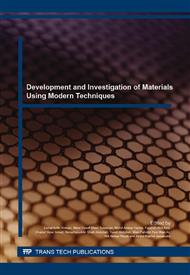p.48
p.52
p.57
p.61
p.66
p.71
p.77
p.82
p.87
Synthesis and Characterization of PZT Doped Lanthanum, Neodymium and Yttrium Using Sol Gel Method
Abstract:
PZT ceramic is synthesis by using sol gel method.Introducing a dopant to the pure PZT can help to enhance the properties of the piezoelectric ceramic. The effects of sintering temperature on phase formation, densification of the ceramics have been investigated using XRD, SEM and Archimedes method. The bulk density and porosity of PZT decreased as the sintering temperature increased.
Info:
Periodical:
Pages:
66-70
Citation:
Online since:
January 2016
Keywords:
Price:
Сopyright:
© 2016 Trans Tech Publications Ltd. All Rights Reserved
Share:
Citation:


